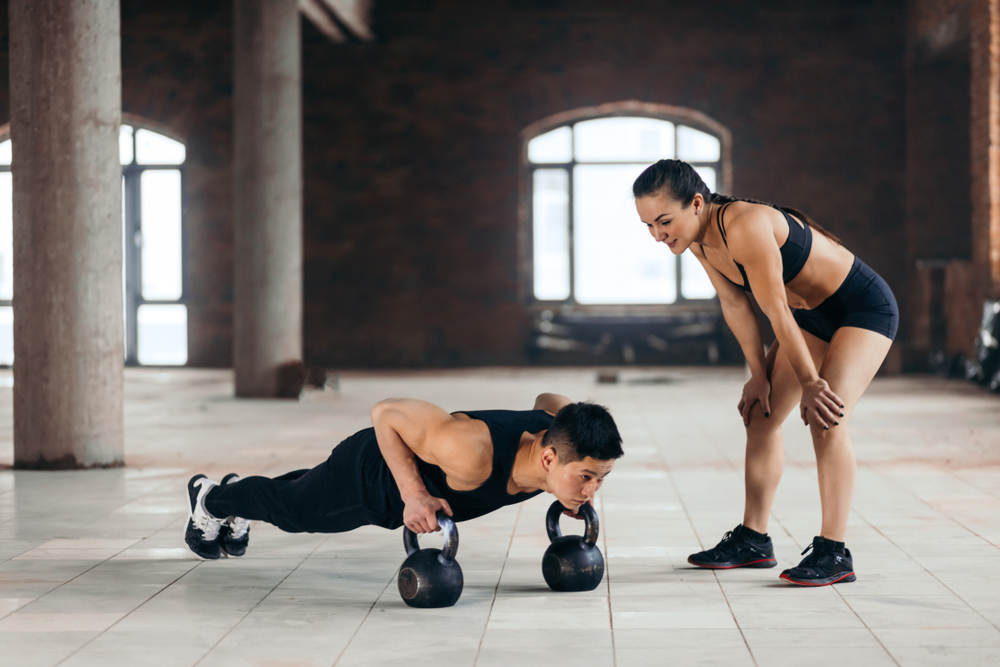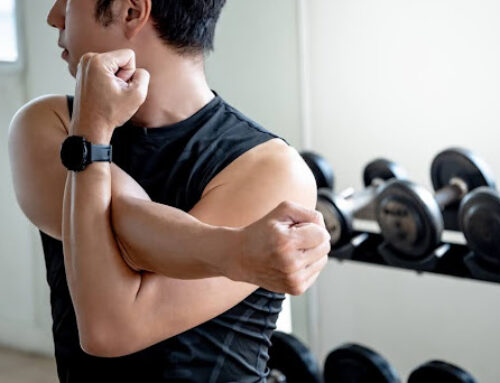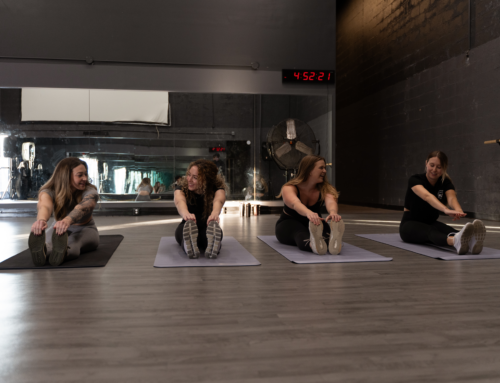We all have different goals when it comes to why we exercise. It might be to build strength or muscle, to lose body fat, to keep your heart healthy, or to manage a health condition.
Depending on the goal, the type of workouts you do might change. But there is one type of training, regardless of why you hit the gym, that everyone can benefit from and should incorporate into their routine, and that is functional training.
Functional training, also sometimes referred to as functional strength training, functional fitness, integrated training, or optimum training, is built around exercises that mimic the ones you use in everyday life. These movements help you maintain the ability to perform basic daily tasks and ensure you stay active, mobile, and independent with age.
While functional training becomes even more important as we get older, people of all fitness levels, and even those who don’t go to the gym, can benefit from functional training.
Whether you’re a kid, a teenager, entering mid-life, or in your senior years, we all perform the same basic movements, such as walking up and down stairs, bending to pick things up, reaching overhead, or carrying things like groceries.
To do these things safely, you need to train your body to move the way it’s designed to move. You might get away with poor movement patterns or weak stabilizing muscles for a while, but eventually, it will catch up with you in one way or another.
Additionally, functional training can improve performance and lower the risk of injury, which is especially important if you are an athlete, lift weights, run, or do high-impact cardio such as HIIT.
Whether you’re an athlete, a busy parent, or just want to stay strong and independent as you age, anyone can benefit from functional training.
What is Functional Training and How It’s Used in Exercise
Functional training is a style of exercise that focuses on improving how your body moves, not just how it looks or how strong you can get. The goal of functional training is to make your body stronger, more stable, and more capable of handling real-world, everyday life demands without pain or limitation.
Instead of isolating one muscle at a time, functional training trains multiple muscles and joints to work together the way they naturally do in daily life by mimicking movements you already do every day. By training these movement patterns under controlled conditions, you teach your body to move safely and efficiently in the situations you face both in and out of the gym.
Take sitting down or standing up, for example. The functional exercise used would be a squat. Yes, this is common in traditional strength training, too, but the goal isn’t to build big quads; it’s to develop the strength and stability you need for this fundamental movement pattern.
Similarly, a lunge mimics climbing stairs or stepping forward to pick something up. A farmer’s carry builds the strength and grip you need to hold heavy bags or move furniture safely. These are just a few examples. We’ll provide you with more exercises that mimic real-life movements and other tips to get the most out of functional training a little further down.
Often, functional training centers around bodyweight movements. However, it can include free weights, kettlebells, resistance bands, medicine balls, or suspension trainers. These tools allow you to add resistance and challenge your balance, coordination, and core strength, making the training even more effective.
When done consistently, functional training builds strength that is less likely to result in injury, puts less strain on your joints, and creates a strong foundation that makes everyday life easier and safer.
How Functional Training Differs from Other Types of Exercise
Typically, when someone joins a gym or commits to a training program, their focus is usually on getting stronger or improving how they look.
The primary purpose of functional training has nothing to do with aesthetics, achieving squat or chest press PRs, or improving performance outcomes. While those things often improve naturally when you incorporate functional exercise into your training routine, the goal of functional training is to help your body work the way it’s supposed to.
Functional training trains you for life, not just for the mirror, the gym floor, or your sport. Here’s how it differs from a few common workout styles:
Traditional Strength Training vs Functional Training
Most traditional strength training programs include multi-joint, compound exercises such as squats, which are also involved in functional training. But traditional strength programs also focus heavily on isolation exercises that target one muscle at a time.
The goal is usually to get stronger and build muscle, but it doesn’t always translate to real-world strength or fluid movement. In fact, if you aren’t moving properly or balancing your training, it can lead to muscle imbalances, poor posture, or even injury over time.
Functional training builds strength that’s usable in everyday situations by training multiple muscles and joints together, improving stability, balance, and control.
HIIT vs Functional Training
High-intensity interval training (HIIT) is short, high-intensity training that involves periods of all-out effort followed by brief periods of recovery. HIIT is excellent for fat burning, building endurance, and improving cardiovascular health, but the end goal isn’t proper movement patterns.
Functional training is slower and more intentional, prioritizing safe and efficient movement first to help promote functional ability and quality of life. Then, if you want to advance, you can add intensity once you’ve built a solid foundation.
Steady-State Cardio vs Functional Training
Steady-state cardio, such as jogging, incline walking, cycling, or swimming, burns calories, enhances endurance and heart health, but it doesn’t address strength, balance, or mobility.
Functional training trains your entire body to move well and handle different physical demands, filling the gap cardio leaves behind.
Yoga vs Functional Training
Yoga improves flexibility, balance, and mental focus, but it doesn’t build the same level of strength or power needed for many daily activities. Functional training incorporates load, resistance, and real-life movement patterns to enhance strength while improving flexibility and control.
Benefits of Functional Fitness Training
By mimicking the way the body moves and strengthening multiple muscle groups together, functional training helps you build a body that works better, feels more stable, and stays resilient over time.
There are many benefits of functional training. For starters, this style of training is highly accessible, doesn’t require equipment, and can be tailored to almost any fitness level. Additionally, functional training can be very time-efficient. Because many functional exercises target multiple fitness elements (strength, cardio, balance, and flexibility), you can get more done in less time.
However, the real payoff is in how it carries over to everyday life, helping you move more easily, avoid injuries, and stay strong for the long run. Here are some of the key benefits of adding functional training to your routine:
Real-Life Carryover
The main goal of functional training is to make life easier. Climbing stairs, carrying laundry, getting out of a low chair, or running around with kids will all feel easier and less tiring when your body is trained to handle those movements efficiently.
Improves Flexibility and Mobility
Many aches and pains come from being stiff or unable to move through a healthy range of motion. Functional training uses natural, multi-joint movements that loosen tight muscles and strengthen the ones that keep you upright and stable. This improves flexibility and mobility, making daily tasks like bending, reaching, or getting up off the floor easier and safer, especially as you age.
Improves Balance, Stability, and Coordination
Functional exercises often challenge your balance by engaging your core and stabilizing muscles. Over time, you develop better control of your movements, which not only improves performance in the gym or sports but also helps prevent injuries and falls, or even those awkward stumbles and missteps in everyday life.
Lowers Risk of Injuries In and Out of the Gym
Most injuries happen when your body isn’t prepared to handle an unexpected load, twist, or reach. Functional training strengthens muscles, joints, and connective tissue in the patterns you use, making them more resilient. It builds proper movement habits, so whether you’re picking up a child, twisting to grab something from the backseat, or going heavy on deadlifts, you’re less likely to tweak your back or strain a muscle.
Builds Overall Strength
Unlike some isolated weightlifting moves that only work a single muscle, functional training builds total-body strength that works in real life. Squats, carries, pulls, and pushes train multiple muscles together, making you stronger for everything from lifting a suitcase into an overhead bin to pushing a heavy cart or performing well in your sport of choice.
Improves Core Strength and Posture
Many functional moves naturally build a strong, stable core. This helps protect your spine, reduces back pain, and improves posture, making everything you do feel lighter and safer.
Joint-Friendly
Because functional training teaches proper alignment and recruits supporting muscles, it takes pressure off vulnerable joints. This means you can get stronger without the aches, pains, and long-term wear and tear that often come from repetitive or poorly balanced training.
Supports Long-Term Independence
Functional training keeps you strong enough to maintain independence later in life. It helps you stay capable of doing basic tasks on your own well into your senior years, which is one of the most valuable benefits of any workout style.
Enhances Performance
Functional training improves how your body moves, making every workout more effective. In the gym, better movement patterns help you lift safely, train harder, and see faster progress without setbacks. For athletes, the same principles translate into improved power, agility, coordination, and reaction time during practice or competition.
Who Can Benefit From Functional Training
Functional training works for everyone, regardless of age, experience level, or fitness goal. Here are some specific groups and how they can benefit from making functional exercises part of their routine:
- Beginners wanting strong movement foundations: Learn proper form, build balanced strength, and develop good habits early to set yourself up for long-term success.
- Aging adults: Maintain flexibility, keep joints healthy, and stay ache-free while building the strength you need to remain active as you age.
- Older adults focused on independence: Functional training uses safe, simple movements to build strength, improve balance, and lower the risk of falls, helping you keep up with daily activities on your own.
- Athletes seeking sport-specific power and coordination: Train the movement patterns you need to react faster, move more efficiently, and perform better in your sport.
- People returning to fitness post-injury: Rebuild strength and mobility safely, retrain movement patterns, and reduce the risk of reinjury.
- Gym-goers looking to gain strength or power and avoid injury: Improve lifting mechanics, build full-body stability, and make progress without unnecessary wear and tear.
No matter your goal, functional training builds a stronger, more capable body that performs well in the gym, in sports, and in everyday life.
How to Incorporate Functional Training into Your Workouts
Functional training can be the foundation of your entire fitness routine or added to complement what you already do. Whether you’re focused on traditional strength training, athletic performance, or general fitness, functional training has a place in your workout routine.
Functional strength exercises help improve movement quality, make your current workouts safer and more effective, and build strength you can use outside the gym.
Here are a few specific functional training exercises to get you started, along with tips on incorporating them into your current training program or creating an independent functional strength training routine.
Best Functional Training Exercises That Mimic Real-Life Movements
- Squats – Build lower-body strength for sitting, standing, and lifting safely from the ground.
- Lunges – Improve balance and stability for climbing stairs, stepping, and reaching forward.
- Single-Leg Deadlifts – Improve balance and strength on one leg, crucial for activities like walking on uneven surfaces.
- Push-Ups – Work the chest, shoulders, and triceps, improving upper body pushing strength.
- Pull-Ups – Strengthens the back and arms, improving upper body pulling strength.
- Planks – Strengthen the core, which is vital for stability and posture.
- Farmer Carries – Strengthen grip, core, and total-body stability for carrying groceries, luggage, or other loads.
- Rotational Core Work – Improve twisting and turning strength for sports and everyday activities like reaching or swinging.
- Any Push and Pull Patterns – Strengthen the muscles you use to push open doors, pull heavy items, or perform upper-body lifts.
Tips to Get the Most Out of Functional Training
You can approach functional training in different ways depending on your goals.
If you’re already following a traditional program or athletic training plan, you can dedicate one workout day each week to functional training or add a few functional exercises to your current sessions. These can go early in your workout, when your energy and focus are highest, or at the end as accessory work to reinforce good movement patterns.
If you want functional training to be your primary focus, you can build entire workouts around it. A balanced session might include a squat or lunge variation, an upper-body push and pull, a carry exercise, rotational core work, and a mobility-focused finisher. This approach builds strength, balance, and coordination in every major movement pattern.
Regardless of how you plan to incorporate it, keep these tips in mind:
- Focus on form first, then add load. Quality movement comes before weight or speed to reduce injury risk.
- Use multi-joint, compound moves. Train multiple muscles and joints together for real-life strength.
- Train movements, not just muscles. Build skills that translate to everyday activities and sports performance.
- Combine strength, balance, and mobility work. This creates a strong, capable body that performs well in all areas of life.
If you aren’t sure how to incorporate functional strength exercises into your current training program, how to build a functional training workout plan, and especially if you are a beginner that is new to exercise, it’s a good idea to hire a certified personal trainer.
Working with a personal trainer knowledgeable in functional training can help you get even more out of it. A trainer can assess your movement, correct imbalances, and build a plan that matches your fitness level and goals, helping you see progress faster while staying safe.
Conclusion
Functional training is one of the best ways to make everyday life easier now and to help you stay strong, capable, and independent in the future. It builds real-world strength, improves mobility, reduces your risk of injury, and helps you move through everyday life activities with more ease and confidence.
If you don’t train these movement patterns already, adding functional exercises to your current program can enhance your traditional workouts or athletic training, reduce the risk of injury, and improve overall performance for better results.
Whether you’re chasing athletic goals, lifting to get stronger or change your body composition, trying to stay active as you age, or just want workouts that truly carry over outside the gym, functional training delivers.
At Carbon Performance, our personal trainers specialize in helping you get stronger for life, not just for the weight room, a swimsuit, or your sport. Our trainers create custom programs that incorporate functional training based on your goals.
Personal training is your shortcut to success. When you work with a trainer, you have someone right there teaching you proper form, assessing your movement patterns, and guiding you every step of the way.Ready to see the difference functional training can make in your everyday life? Whether you want the expertise of our personal trainers or plan to tackle functional training on your own, find a Carbon Performance gym near you and join our fitness community today.






